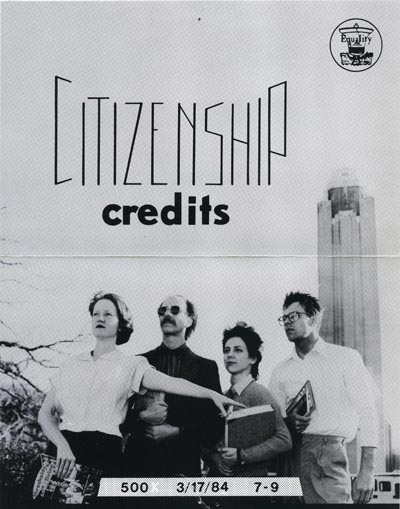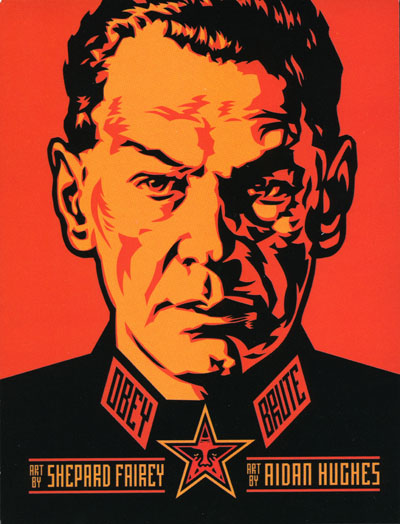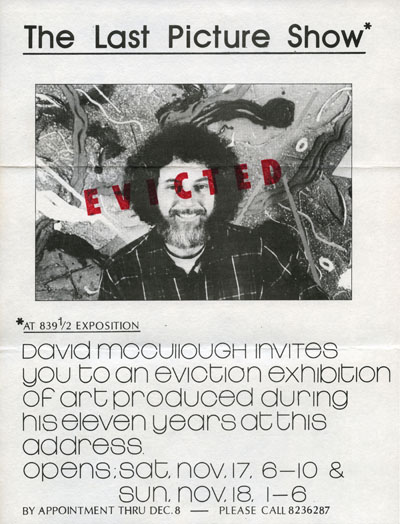Tucked behind the new exhibit Hotel Texas: An Art Exhibition for the President and Mrs. John F. Kennedy at the Dallas Museum of Art, there’s a second show opening this weekend devoted to the history of local art in Dallas called DallasSITES: Charting Contemporary Art, 1963 to Present. The positioning of the exhibition is rich enough; before it closes, I’m sure more than a few fervent local art gadflies will quip about how the museum has acknowledged, yet almost hidden this exhibit, blocked off by galleries displaying work that once hung in the hotel suite where John F. Kennedy spent his last night. The proximity to that JFK exhibit is also of note. That event, which transpired 50 years ago this November, is interpreted by the curators of DallasSITES, Leigh Arnold and Gabriel Ritter, as a pivot point, a historical moment that birthed Dallas’ modern era. That point, I believe, can be strongly made. With the assassination came a new kind of civic self-awareness in Dallas and a fervor around deepening and strengthening our civic and cultural sensibility.
DallasSITES offers an intriguing project: how to track the occurrences of local art activity after that pivotal moment fifty years ago with coherent historical categorization. What we get is a useful first draft. The categories offered by the DMA exhibit are geographical. One large wall in the gallery space is occupied by a massive timeline which shows five locations – Uptown, the Arts District/Downtown, South Dallas/ Fair Park, Oak Cliff, and “outlying areas” – each with their own timeline. Ephemera and artifacts – from photos and postcards to posters and articles – are pinned to their respective dateline. An adjacent wall is taken over entirely with a giant map of Dallas depicting each of the events from the timeline located with a red dot on the map. The effect is to literally map Dallas culture, and by doing so, grow awareness and sensitivity to the locations that hold the roots of cultural growth. And in a city with as uneasy a relationship to history as Dallas, providing a basis for geographic continuity offers a coherent method for emphasizing that those roots exist.

Each of these areas are given more in depth treatment with break out displays. Running down the center of the gallery, glass cases contain items such as box projects created by artists from 500x, copies of the journal Art Prostittue, and video interviews with local art world protagonists like the South Dallas Cultural Center’s Vicki Meeks. Four inset alcoves along the wall opposite the timeline contain the only actual art in the exhibition. The first is an oversized, panoramic photo of the Oak Cliff Four (including Wade, George Green, Jim Roche, and Jack Mims) plus artist Mac Whitney, the five making up the association of artists whose work seems to dominate local art activity from the late 1960s through the 1970s. There’s also a video monitor showing classic video pieces by artists like William Wegman and Martha Rosler. The local connection here is that these works were exhibited locally by the ever-under-lauded Dallas Video Festival, a way of picking up one of the subplots of the exhibition, namely, that we’ve always been good at showing new art from elsewhere. (Shepherd Fairey at Forbidden Gallery and Emporium in 1990? Not bad.)

The two other pieces here are the only legitimately locally-produced art works in the show. One is a piece by the collective Toxic Shock made for exhibition at 500x during the 1984 Republican National Convention. The faces of the artists in the all-female collective, including Frances Bagley, Julie Cohn, Linda Finnell, Debora Hunter and Susan Magilow, are cast in a horizontal strip of concrete and set on a shelf riffing tongue-in-cheek on some political posturing from the time: “Two Jews, One Lesbian, and Other Famous People.” The other piece is by the 1990s-era art collective Good/Bad, and it includes video from some of the group’s outlandish performances playing in a loop on a television that is inside a green dumpster.
By far the most enveloping aspect of the show, though, is the ephemera, and the presence of all these items from the past in a single setting raises more questions than they answer. What exactly is the relation between these various eras of activity? Can an argument be made for continuity or development between the independent parts on the timeline, or does a lack of continuity or relation between activities spread across different moments in time reflect something about a city that doesn’t prize historical consciousness?
Placing the items on discrete, location-based timelines not only helps demarcate, or map, the logistics of our city’s cultural output, but it draws attention to the gaps. The 1960s seem notable for the opening of galleries devoted to contemporary art, such as Nye Galleries and Atlier Chapman Kelley, and later on Janie C. Lee Gallery. The transition to the 1970s brings on a flood of activity, primarily by the Oak Cliff Four, that suggests that “Dallas Art” has transitioned away from the Texan landscapes of a Jerry Bywaters and towards the bombastic, oversized Texas-twanged Pop of a Bob Wade. (Photos show Wade riding a giant, inflatable weenie and the massive “earth work” map of the United States, carved into the dirt in 1976 near the construction of Interstate 635.) But then Oak Cliff goes dormant for some time, suggesting exterior cultural conditions as much as the reality that so much of the seeming momentum was based around the activity of a few key protagonists.

Likewise, other scattered landmark events feel singular. While the founding of local stalwarts like the South Dallas Cultural Center and 500x certainly mark an important moments in the maturation of the city’s cultural life, the less well-known founding of the Northwood Institute art school, which, during its brief life, brought giants like Robert Smithson to town to lead workshops with student artists, feels like a marked loss. And as one might expect from an exhibition comprised mostly of fading old flyers and photographs, other events and milestones feel distant and faded. The antics of Pam Gay at the New Arts Festival in 1977, the artists in 500x in the early 1980s, or even the Angstrom Gallery in the 1990s feel both disconnected and uncannily associated with the present. The hairstyles, the clothing, and photographic technology has changed, but the locations and the modes and forms of the self-starting art activity remain familiar. It almost suggests that the dialectic of local art history takes the form of a series of echoes of an unfamiliar, yet inextricably related antecedent.
Perhaps the piece in the exhibition that resonated most deeply for me was an issue of Newsweek published in 1972 that is pinned to the timeline and opened to an article that reports on the Dallas art scene at the time. “Now [Dallas] sparkles with activity, brash optimism, and an ambience,” the article reads, “that will make it one of the rarer art cities in the country.” It’s exactly the kind of writing and thinking that we continue to repeat today, and it also helps explain why so much of the past presented in the exhibition feels present and promising, and yet ultimately ambivalent. Dallas’ art story is a history of fits and starts, just as Dallas is a city defined by a myth of endless beginnings. DallasSITES seems to suggest a Pegasus-like rising upwards, towards a goal, however, that remains ever elusive.
Here are the gallery openings:
THURSDAY
2013 CVAD MFA SHOWCASE at the UNT Art Gallery – May 23: 6-8 p.m. 1201 W Mulberry St., Denton, TX 76201.
“Project T” by Pierre Durand, at the Gallery 422 at The Workroom – May 23 : 5-8 p.m. 422 Singleton Boulevard, Dallas, Tx 75212.
FRIDAY
Dirty New Rococo at Homeland Security – May 24: 4-10 p.m. 1415 Beaumont St. Dallas, TX 75215
“First Impressions” by Katie Crowell, “Souvenir” by Fatma Rana Şahin, and “Woman Still Standing” by Lori Snyder, at the University Of Texas at Dallas – May 24 : 6:30 PM – 8:30 p.m. Visual Arts Building, 800 West Campbell Road, Richardson, Tx 75080.
SATURDAY
“15 Minutes to Curtain!” by Elizabeth Bogard, Bernard Bortnick, Steve Danner, Jenny Hong DeLaughter, Cuyler Etheredge, Jerome-Achille Garron, Philip Goodman, Janice Hamilton, Melissa Hayes, Gina Marguerite, Roberta Masciarelli, Cristina Nava, and Samantha Rodriguez, at the Bath House Cultural Center – May 25 : 7-9 p.m. 521 E. Lawther, Dallas, Tx 75218.
“Opening Up” by Daniel Leightion, at WAAS Gallery – May 25: 7-10 p.m. 2722 Logan Street, Dallas, Tx 75215
“The Puzzle Aesthetic” book signing by Jim Lively, and “Fantastic Realism” by Sergei Rodionov, Magi Calhoun, Santiago Ribeiro, Liba W. Stambollion, Katrin Alvarez, and Otto Rapp, at Luminarte Art Gallery – May 25 : 7-10 p.m. 1727 East Levee, Dallas Tx 75207.
SUNDAY
“2013 Membership Exhibition” by the Texas Visual Art Association – May 26: 2-4 p.m. Medical City, 7777 Forest Lane, Dallas, Tx 75230.
Photo at top: “Dare to Dream” exhibition announcement 1989. South Dallas Cultural Center, Office of Cultural Affairs, City of Dallas. Paul Rogers Harris papers, 1959-2001. Dallas Museum of Art Archives.




